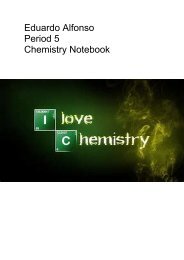You also want an ePaper? Increase the reach of your titles
YUMPU automatically turns print PDFs into web optimized ePapers that Google loves.
• When a particle is heated it stores energy within itself.<br />
• This potential energy does not raise the temperature of the substance.<br />
• The remaining energy speeds up the particles, or their kinetic energy.<br />
• The particles in any given collection of atoms has a wide range of kinetic energies.<br />
• The particles of all substances have all the same amount of kinetic energy.<br />
• All particles of a substance stop moving if they reach a certain very low temperature.<br />
• Absolute zero is the point in which all substances have zero kinetic energy.<br />
• The Kelvin scale reflects the relationship between temperature and kinetic energy.<br />
• The particles in a solid are not free to move.<br />
• Solids are very dense and are not very easy to compress.<br />
• When solids are heated, their articles begin to vibrate much faster.<br />
• The point at which a solid becomes a liquid is called the melting point while the reverse<br />
is called freezing point.<br />
• Ionic solids have a very high melting point due to their stronger bonds.<br />
• Molecular solids have quite low melting points.<br />
• Not all solids melt, some like wood and sugar cane, begin to decompose when they get<br />
too hot.<br />
• Most solid substances are crystalline in which particles are arranged in an orderly,<br />
repeating, three-dimensional pattern.<br />
• Crystals are classified into seven groups or crystal systems, they also have angles and<br />
faces.<br />
• The seven crystal systems differ in terms of faces and angles.<br />
• Some solid substances can exist in more than one form, such as carbon.<br />
• Allotropes are two different molecular forms of the same element in the same physical<br />
state.<br />
• These have different properties because they are structured differently.<br />
• An amorphous solid lacks an ordered internal structure. Rubber, Plastic, and Asphalt are<br />
amorphous.<br />
• Not all solids are crystalline in form as these are amorphous.<br />
• Glass is a transparent fusion product of an inorganic substance that has cooled to a rigid<br />
state without crystalizing.<br />
• Glasses are sometimes called super cooled liquids as its structure reflects that of a free<br />
flowing liquid. This property causes it to shatter into jagged and irregular shapes when it<br />
is broken.<br />
•<br />
123



